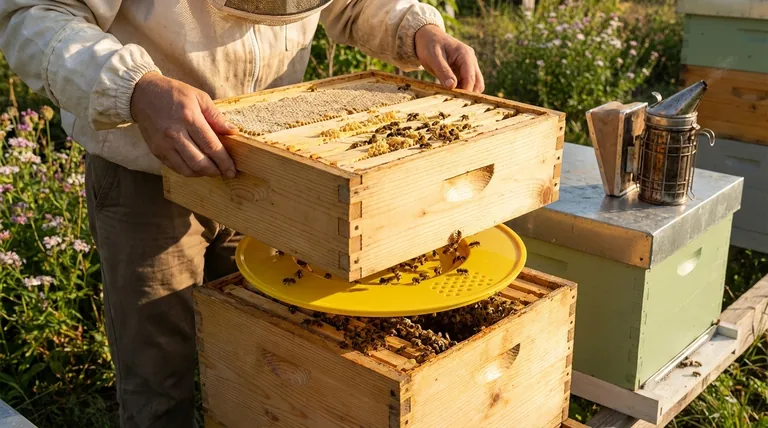Once bees move down through a bee escape board, they are unable to re-enter the upper honey super they just left. They join the main colony in the brood boxes below, effectively clearing the honey super of bees so the beekeeper can harvest it.
A bee escape board is a one-way gate that leverages the bees' natural instinct to move down and cluster at night. It provides a slow, passive, and low-stress method for separating bees from honey supers, preparing them for a calm and straightforward harvest.

How a Bee Escape Board Functions
A bee escape is placed between the honey supers you intend to harvest and the brood boxes where the main colony lives. It acts as a passive filter, clearing bees over approximately one day.
The Core Principle: A One-Way Gate
The board contains a small, specially designed passage. Bees in the upper honey supers can easily find their way through this passage to move down into the brood nest below.
However, the design of the passage makes it nearly impossible for them to find the entrance from below and travel back up. It is a simple but highly effective one-way system.
Leveraging Natural Bee Behavior
The primary behavior exploited by the board is the bees' instinct to cluster at night. As evening approaches, bees naturally migrate downwards from the cooler, more isolated honey supers to join the warmth and security of the main colony cluster in the brood boxes.
Once they pass through the escape, they are prevented from returning to the honey super the next day.
The Maze-Like Design
Different types of bee escapes use slightly different mechanisms. A common "triangle" design, for example, takes advantage of a bee's instinct to turn to the right when seeking an exit.
The bees easily exit the large opening of the triangle from above, but from below, they encounter only solid wood and cannot locate the tiny corner openings to get back in.
Understanding the Trade-offs
While effective, a bee escape is not the right tool for every situation. Its effectiveness depends on patience and proper hive conditions.
It's Not Instantaneous
The primary trade-off is time. It typically takes 24 to 48 hours for the super to become mostly free of bees. This is much slower than active methods like using a bee brush or a fume board, which work in minutes.
It Requires a Brood-Free Super
A bee escape will not work if there is brood (bee eggs and larvae) in the honey super. Nurse bees will not abandon the brood, and they will remain in the super, defeating the purpose of the board. Ensure the queen has been kept out of the honey supers with a queen excluder.
The Harvest Becomes Calm and Gentle
The key benefit is a low-stress harvest for both the bees and the beekeeper. You are not aggressively brushing bees off frames or using chemical fumes. When you return a day later, you simply lift off a quiet, nearly empty box of honey.
Making the Right Choice for Your Harvest
Deciding whether to use a bee escape comes down to balancing your need for speed against your desire for a calm harvest.
- If your primary focus is a calm, low-stress harvest: The bee escape is the ideal tool, as it works passively with the bees' natural behavior.
- If your primary focus is speed and efficiency: Faster methods like a bee blower or fume board may be better suited to your needs, especially for larger operations.
- If you are a new beekeeper: The gentle and straightforward nature of the bee escape makes it an excellent and forgiving method to learn with.
Using a bee escape allows you to conduct a harvest that respects the colony's natural rhythms and temperament.
Summary Table:
| Aspect | Description |
|---|---|
| Primary Function | One-way gate that allows bees to move down but prevents them from returning up. |
| Key Benefit | Enables a low-stress, passive method for clearing honey supers of bees. |
| Time Required | Typically 24 to 48 hours for the super to become mostly bee-free. |
| Ideal For | Beekeepers prioritizing a calm harvest that works with bees' natural instincts. |
| Key Requirement | Honey supers must be brood-free (ensured by using a queen excluder). |
Ready for a Calmer, More Efficient Harvest?
Achieve a low-stress honey harvest that respects your colony's well-being. HONESTBEE supplies commercial apiaries and beekeeping equipment distributors with the high-quality, durable tools needed for successful operations—including reliable bee escape boards and queen excluders.
Let's discuss how our wholesale-focused solutions can streamline your beekeeping process. Contact our team today to learn more about our products and pricing.
Visual Guide

Related Products
- Circular Labyrinth Bee Escape for Efficient Hive Management
- High-Efficiency Diamond Maze Bee Escape for Clearing Supers
- HONESTBEE Multi Exit Plastic Bee Escape Board for Efficient Honey Harvesting
- Professional Durable Two-Piece Plastic Bee Escape
- Efficient Hive Clearing: HONESTBEE 8-Way Plastic Bee Escape
People Also Ask
- What happens if an escape board is left on for too long? Avoid this common harvesting mistake
- What is a bee escape and why is it used in beekeeping? A Guide to Gentle Honey Harvesting
- What is the function of an escape board in beekeeping? A Gentle Guide to Harvesting Honey
- What is the correct orientation for placing Triangular Escape Boards? Ensure a Stress-Free Honey Harvest
- What happens if Triangular Escape Boards are left on for more than 24 hours? Risk of Bee Re-Entry and Failed Harvest



















